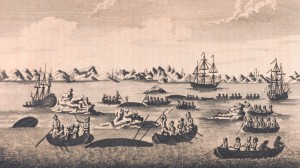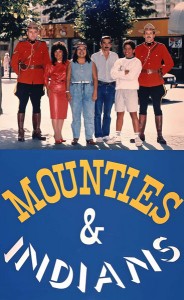3.7
“…A text is made of multiple writings, drawn from many cultures and entering into mutual relations of dialogue, parody, contestation… ” -Roland Barthes, “The Death of the Author,” p. 148.
My assigned section of GGRW: Start “Babo Jones sat in the Staff Room [19]” End “A white man,” said Norma …..”…” [30]
Babo Jones is a reference to Herman Melville’s character Babo in Melville’s novella “Benito Cereno.” Babo is the leader of the slave revolt on board the San Dominick (Flick 145). When Amasa Delano boards the ship he believes that everything is going according to plan; however, he is unaware that there has been a revolt on board, in which the slaves, under the direction of Babo, rose up and slaughtered the majority of the crew (New York times). Babo pretends to be Captain Cereno’s devoted servant, but in fact, he is closely monitoring Captain Cereno’s movements.
Sergeant Cereno refers to Captain Cereno in Herman Melville’s “Benito Cereno.” While it appears that Cereno is acting autonomously, Cereno is in fact, under the command of his “servant” Babo (Flick 146).
The “Pinto” refers to a horse with a “piebald” coat. It is also the name of a model of Ford automobile. Flick notes that Pinto horses are prominent in the drawings of the prisoners who were held at Fort Marion (146). Flick also notes that there may be a play on the word “Pinta” which was the name of Columbus’s ship. This may explain the link between the Pinto car and the puddle of water. Babo imagines that the “Pinto looked a little like a ship” (King 27).
Jimmy Delano is most likely a reference to Columbus Delano, a lawyer and politician, who worked as the head of the Bureau of Indian Affairs during the presidency of Ulysses S. Grant (1822-1885). Flick describes how Delano defended the Bureau of Indian Affairs against charges of mistreatment of the Native Americans in the Red Cloud Agency in South Dakota in 1875 (146).
Martha Old Crow : She is a medicine women who also appeared in King’s Medicine River (Flick 146).
George Morningstar: A reference to George Armstrong Custer. Custer was a military captain during the Sioux Wars. He achieved notoriety for leading an outnumbered infantry into battle against Sioux and Cheyenne warriors. Custer and all of his men were killed (Encylopedia of World Biography). To cite the Encyclopedia entry on Custer: “Custer was a man so paradoxical that he could fight corruption in the Indian Bureau to the disservice of his own carrier, yet also order a charge to kill Native Americans.” Custer was given the name “Son of the Morning Star:” by the Arikaras in Dakota (Flick 146). George’s comment “Right…And I’m General Custer” (384) makes this allusion to George Armstrong Custer quite evident.
John Wayne is referenced frequently throughout King’s novel. John Wayne was an iconic Hollywood actor featured in numerous Westerns. He has come to epitomize the glamourized Cowboy figure of the Hollywood Western. Flick tells us that Native Americans have boycotted his films in the past due to the discriminatory portrayal of Native Americans (147). In an interview with Playboy in 1971, Wayne reveals some troublingly racist, sexist and homophobic assumptions.
The Lone Ranger is a prominent figure in the American literary and filmic imaginary. The Lone Ranger is portrayed as a masked man, who has a devoted “Indian” companion named Tonto. He has served as the hero of numerous films, western books, radio productions and television series.
Ishmael : The name of a character in Herman Melville’s Moby Dick.The opening line of Moby Dick has become one of the most iconic in American literature: “Call me Ishmael.” (Flick 143).
Robinson Crusoe : Refers to the hero of Daniel Defoe’s now iconic novel Robinson Crusoe published in 1719. Flick draws the connection between Crusoe’s shirt: “the one with the palm trees,” (King 9) and Defoe’s desert island story.
Hawkeye : Apparently borrowed from Native American culture, Hawkeye is a name that circulates in American “frontierest” literature and film. He is the hero of numerous Hollywood features.
Works Cited
Flick, Jane. “Reading Notes for Thomas King’s Green Grass Running Water.” Canadian Literature 161-162. (1999). Web. April 04/2013.
King, Thomas. Green Grass Running Water. Toronto: Harper Collins, 1993. Print.
(*All of my other research sources are linked directly into the text!)






